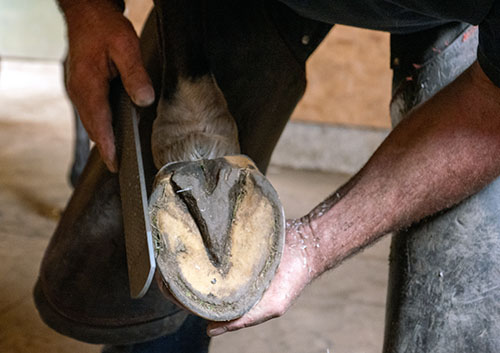Farrier Terminology
Feb 13, 2023

As winter transitions into spring over the following months, it will be more important than ever to closely monitor your horse’s hooves. Metabolic fluctuations and dietary changes due to lush, green pasture lead to faster hoof growth, so farrier visits may need to be scheduled more frequently than in the winter.
Don’t wait until your horse’s hooves look distressed before making your next farrier appointment. Especially for horses who are shod, being proactive is key to keeping their shoes secure through the muddy season.
Do you ever feel like your farrier is speaking another language when discussing your horse’s feet, though? Listed below are the definitions of some common words and phrases to help you understand what they are saying:
As you spend more time in the saddle this spring, remember that proper hoof care is essential for a healthy animal! Your local Co-op carries many equine essentials, including basic hoof care supplies. Find the nearest location here.
For more content like this, check out the latest issue of The Cooperator.
Don’t wait until your horse’s hooves look distressed before making your next farrier appointment. Especially for horses who are shod, being proactive is key to keeping their shoes secure through the muddy season.
Do you ever feel like your farrier is speaking another language when discussing your horse’s feet, though? Listed below are the definitions of some common words and phrases to help you understand what they are saying:
- Coffin bone —the most distal bone of the limb which is encased by the hoof capsule. It is often referred to as the pedal bone.
- Navicular bone — a small, crescent-shaped bone that attaches to the coffin bone. It protects the coffin joint and aids in the horse’s movement.
- Coffin joint – the joint between the coffin bone, navicular bone, and short pastern.
- Coronary band — the area at the top of the hoof wall where the hoof meets the hairline.
- Laminae — the soft tissue that attaches the hoof wall to the internal structures of the hoof.
- White line — the laminae that wrap around the sole of the hoof and connect the hoof wall to the sole.
- Wall – the hard outer covering of the hoof.
- Sole — the underside of the hoof that protects the coffin bone from injury.
- Toe — the front of the hoof.
- Frog — the V-shaped pad on the underside of the hoof that acts as a shock absorber when the horse moves.
- Bars — the inward folds of the hoof wall that start at the heel and run down the frog’s outer edge to help maintain the integrity of the hoof.
- Quarters — the narrowest area of the hoof wall. The hoof wall is widest at the toes and tapers down as it approaches the quarters.
- Heel bulbs — the soft cushions at the very back of the hoof.
- Lateral — towards the outside.
- Medial — towards the inside.
- Anterior — front of the hoof.
- Posterior — back of the hoof.
- Center of rotation — the center of balance in the horse’s hoof.
- Breakover — the period in a horse’s gait when the heel begins to lift as the horse steps forward.
- Brushing — when a horse hits its opposite leg with the hoof that’s in the air while stepping forward.
- Dishing — when a horse’s hoof swings in during movement instead of traveling in a straight line.
- Paddling — when a horse’s hoof swings out during movement instead of traveling in a straight line.
As you spend more time in the saddle this spring, remember that proper hoof care is essential for a healthy animal! Your local Co-op carries many equine essentials, including basic hoof care supplies. Find the nearest location here.
For more content like this, check out the latest issue of The Cooperator.